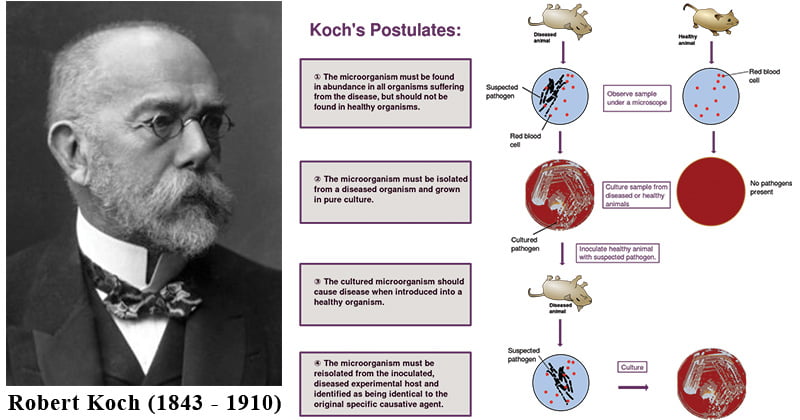“It is obvious that Koch’s Postulates have not been satisfied in viral diseases.”
-Thomas Rivers 1937
During the 2003 SARS “epidemic,” the WHO regularly announced updates about their search for the causative agent of what was claimed to be a new disease. On March 27th, 2003, they admitted that the criteria that needed to be fulfilled in order to prove that there was a new “virus” causing a new disease was Koch’s Postulates: four logic based rules proposed by Robert Koch that have been the burden of proof since the late 1800’s:
“Conclusive identification of a causative must meet all criteria in the so-called “Koch’s postulate.” The additional experiments needed to fulfil these criteria are currently under way at a laboratory in the Netherlands.” -WHO 2003
Original link that seemingly no longer works: https://www.who.int/csr/don/2003_03_27b/en/
Archived link: https://web.archive.org/web/20210105005624/https://www.who.int/csr/don/2003_03_27b/en/
On April 15th, 2003, the WHO stated that the experiments were done and that the criteria for satisfying Koch’s Postulates had been met, thus proving that the “new” disease “SARS’ was caused by a new “Coronavirus:”
Scientists Confirm Virus As Cause of SARS
“Scientists had been almost certain the new form of coronavirus first isolated from sick patients March 21 by the University of Hong Kong was the cause of SARS. But they could not say for sure until they had satisfied what is known as Koch’s postulates _ four scientific tests that verify whether a virus causes a certain disease.
“The Koch’s postulates have been fulfilled, so we can now say for certain that the new coronavirus is the cause of SARS,” said Dr. Klaus Stohr, a World Health Organization virologist who is coordinating the scientists’ work.
The first test requires that the virus be found in all the sick people, but not in healthy people. The second isolates the virus from a sick patient and shows that it multiplies in a lab dish.
The third step uses the virus from the petri dish to make a lab animal sick with the same disease as that seen in humans. The final step requires isolating the SARS virus from the sick lab animal and showing it can grow in a petri dish.”
“Experts said it is reasonable to imagine that the SARS virus came from animals, although its genetic code does not give any clear leads as to exactly where it came from. The genetic makeup is not very close to any of the known animal or human coronaviruses, they say.“

From the above article written by the AP medical writer, we can see that the WHO set out to fulfill FOUR Koch’s Postulates. It is also said that this new “Coronavirus” was genetically not close to any human or animal “Coronavirus,” which raises the question, why did they believe “SARS-COV-1” was a “Coronavirus” to begin with?
From a Genome Biology article, it is also claimed that the WHO set out to fulfill FOUR Koch’s Postulates and it lays out the criteria. It also makes the claim that “SARS-COV-1” genetically is not close to any other “viruses” and the genome sequence doesn’t tell them anything about its origin:
“The organization claimed that its collaborating laboratories have concluded the coronavirus meets all four of “Koch’s postulates” for a causative agent: it must be found in all cases of the disease, it must be isolated from the host and grown in pure culture, it must reproduce the original disease when introduced into a susceptible host, and it must be found in the experimental host so infected.”
“According to Gerberding, apart from providing more stringent diagnostic tests for the virus, and potential long-term goals for antivirals and vaccines, the new sequence is otherwise not very helpful in determining the origins of the virus. Unfortunately the clues from comparing it to the animal viruses have not given us any real leads… We can’t say it’s a mouse virus or a pig virus, or any other animal virus, necessarily, because it just isn’t similar enough to the known species to be able to draw those conclusions,” said Gerberding at a press conference.”
https://genomebiology.biomedcentral.com/articles/10.1186/gb-spotlight-20030417-01
In 2012, Ron Fouchier, the lead researcher for the 2003 “SARS” paper claiming fulfillment of Koch’s Postulates, reiterated that it was KOCH’S Postulates that were fulfilled for “SARS” while speaking about the need to once again fulfill them for MERS:
Ron Fouchier on the New Coronavirus: We Need to Fulfill Koch’s Postulates
“For starters, we’ll find out whether animals get sick from this virus. You can isolate a virus from a patient, but that does not mean they died from it; to show that it causes disease you need to fulfill Koch’s postulates. That’s what we did for SARS, and it’s what we hope to do here; we’ve applied for emergency ethical approval.”
It is clear to see that according to the WHO and lead researcher Ron Fouchier, all four of Koch’s Postulates had been met and a newly identified “SARS-COV-1,” which was not genetically close to any other “Coronavirus,” was the true cause of “SARS.” However, did they really satisfy all FOUR of KOCH’S Postulates for “SARS”as claimed? Below is the full paper by Fouchier et al:
Koch’s postulates fulfilled for SARS virus
 “According to Koch’s postulates, as modified by Rivers for viral diseases, six criteria are required to establish a virus as the cause of a disease1. The first three criteria — isolation of virus from diseased hosts, cultivation in host cells, and proof of filterability — have been met for SCV by several groups2,3,4,5. Moreover, of 96 individuals complying with the World Health Organization’s definition of SARS6 in Hong Kong, 86 (90%) yielded laboratory evidence of SCV infection.
“According to Koch’s postulates, as modified by Rivers for viral diseases, six criteria are required to establish a virus as the cause of a disease1. The first three criteria — isolation of virus from diseased hosts, cultivation in host cells, and proof of filterability — have been met for SCV by several groups2,3,4,5. Moreover, of 96 individuals complying with the World Health Organization’s definition of SARS6 in Hong Kong, 86 (90%) yielded laboratory evidence of SCV infection.
We have tested for the three remaining criteria: production of comparable disease in the original host species or a related one, re-isolation of the virus, and detection of a specific immune response to the virus. We inoculated two macaques with Vero-cell-cultured SCV isolated from a fatal SARS case, and monitored their clinical signs, virus excretion and antibody response. The animals were killed six days post-inoculation (d.p.i.), and we then carried out gross and histopathological examinations of them.
Both SCV-inoculated macaques became lethargic from 3 d.p.i. onwards and developed a temporary skin rash, and one suffered respiratory distress from 4 d.p.i. onwards. The macaques excreted virus from the nose and throat at 2–6 d.p.i., as shown by polymerase chain reaction with reverse transcription (RT-PCR) and by virus isolation (see supplementary information). The isolated virus was identical to that inoculated, as shown by negative-contrast electron microscopy (Fig. 1a) and RT-PCR analysis. Seroconversion to SCV, as determined by indirect immunofluorescence assay using infected Vero cells, was demonstrated in two other SCV-infected macaques at 16 d.p.i.. The virus was also isolated from the faeces of one of these animals (see supplementary information).
At gross necropsy, one macaque had severe multifocal pulmonary consolidation, and SCV infection was detected in lung tissue by RT-PCR and virus isolation. Histologically, both macaques had interstitial pneumonia of differing severity. The one with gross lesions had diffuse alveolar damage, marked by necrosis of alveolar and bronchiolar epithelium and flooding of alveolar lumina with proteinaceous fluid, admixed with fibrin, erythrocytes, alveolar macrophages and neutrophils (Fig. 1b). Occasional multinucleated cells (syncytia) were present in the lumen of bronchioles and alveoli (Fig. 1c). These lesions are indistinguishable from those in biopsied lung tissue and in autopsy material from SARS patients5, including the presence of syncytia in alveolar lumina4.
SCV thus fulfils all of Koch’s postulates as the primary aetiological agent of SARS. This does not exclude the possibility that other pathogens, including human metapneumovirus (hMPV) and Chlamydia pneumoniae, may have exacerbated the disease in some SARS patients. However, these were not present in SCV-inoculated macaques (results not shown), were not found consistently in SARS patients, and do not usually cause the lesions associated with SARS. Moreover, lesions in macaques infected experimentally with hMPV isolated from a non-SARS individual7 were limited to mild suppurative rhinitis and minimal erosion in conducting airways, and disease was not exacerbated in two SCV-infected macaques subsequently inoculated with hMPV (results not shown).“
https://www.nature.com/articles/423240a
In Summary:
- Fouchier et al did not attempt to satisfy Koch’s Postulates but instead Rivers modified and watered-down version of them
- For a breakdown of the differences between Koch’s and Rivers Postulates, see this link:
Thomas Rivers Revision of Koch’s Postulates (1937)
- From the very first sentence, they invalidate their own fulfillment claim as Rivers 6 Postulates are admittedly different from Koch’s 4 Postulates
- They then state that the first 3 RIVERS criteria were met by other researchers and referenced the four papers below:
PEIRIS: J.S.M. Peiris “SARS-COV-1” Paper (2003)
DROSTEN: Drosten “SARS-COV-1” Paper (2003)
POUTANEN: Poutanen “SARS-COV-1” Paper (2003)
KSIAZEK: Ksiazek “SARS-COV-1” Paper (2003)
- However, not a single one of these papers could meet the first requirement of Koch’s Postulates as they could not find their new “Coronavirus” in every case of the disease.
- None of the papers properly purified/isolated any “virus” directly from a sick patient but instead took samples and cultured them in foreign animal cells likely containing added fetal bovine serum, antibiotics, chemicals, nutrients, etc.
- Not a single paper gave detailed methods on how they cultured their “viruses” nor attempted to purify and separate the assumed “virus” particles by ultracentrifugation nor filtration even from their cell culture soup.
- Every one of the papers admitted to other potential pathogens isolated from “SARS” cases that could possibly be the causative agent for disease or act as a cofactor in disease progression
- Fouchier et al then state that they satisfied the last 3 RIVERS criteria themselves
- They used unpurified Vero cell culture supernatant and inoculated two macaques while only observing them for 6 days
- Only one of the macaques developed respiratory distress
- The two macaques had different levels of lung damage at autopsy with one severe and the other one not severe
- Both macaques were lethargic and developed a temporary skin rash, neither of which are symptoms of “SARS:”
Symptoms of SARS
“In general, SARS begins with a high fever (temperature greater than 100.4°F [>38.0°C]). Other symptoms may include headache, an overall feeling of discomfort, and body aches. Some people also have mild respiratory symptoms at the outset. About 10 percent to 20 percent of patients have diarrhea. After 2 to 7 days, SARS patients may develop a dry cough. Most patients develop pneumonia.“
https://www.cdc.gov/sars/about/fs-sars.html
There can be no claim by Fouchier et al nor the WHO as to the fulfillment of Koch’s Postulates as the researchers did not even attempt to fulfill them. Instead, as stated in the very first sentence of the paper, Fouchier et al attempted to satisfy Rivers criteria which are admitted by Rivers himself to be different from Koch’s as:
- He allows for the “virus” not to be found in every case of disease
- He introduces the concept of “virus” carriers
- He states that “viruses” do not need to be grown in culture
The WHO, Ron Fouchier, and the other researchers blatantly lied.
Sadly but not shockingly, Fouchier et al even failed at fulfilling Rivers watered-down version as they:
- Did not isolate a “virus” from a diseased host
- Did not cultivate a “virus” in host cells but instead used monkey kidney cells
- Did not provide any proof of filterability
- Did not produce the same disease in an animal host
- Did not re-isolate a “virus” from the diseased animals
- Did not prove that the immune response was specific
This paper and the disease associated with it are the shining example of the fraud currently being perpetrated on us by virology today.
For further excellent insight into the ridiculous claims made in this paper, I highly recommend taking 30 minutes out of your day to watch Dr. Andrew Kaufman’s “The Rooster in the River of Rats” linked below:







